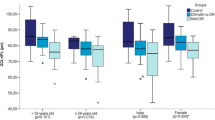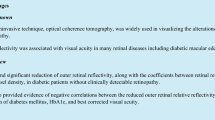Abstract
To evaluate the role of central subfield thickness (CST), cube average thickness (CAT), and cube volume (CV) as imaging biomarkers for severity of diabetic retinopathy within the ETDRS-based grades of retinopathy using spectral domain optical coherence tomography (SD-OCT). This study aims to evaluate the role of macular CST, CAT, and CV on SD-OCT as imaging biomarkers for severity of DR. One hundred ninety-four consecutive cases of type 2 diabetes mellitus were divided according to ETDRS classification: diabetes mellitus without retinopathy (No DR; n = 65), nonproliferative diabetic retinopathy (NPDR; n = 66), and proliferative diabetic retinopathy (PDR; n = 63). Sixty-three healthy controls were included. CST, CAT, and CV were analyzed using SD-OCT. Data were analyzed statistically. Analysis of variance revealed a significant increase in levels of CST, CAT, CV, and LogMAR visual acuity with the increase in severity of DR. Independent t-test revealed significant difference in CST, CAT, and CV between cases with DME and cases without DME. On multivariate linear regression analysis, increase in CST, CAT, and CV were found to indicate the increase in severity of DR. SD-OCT-based imaging biomarkers CST, CAT, and CV are effective tools for documenting the severity of diabetic retinopathy. These imaging biomarkers serve as significant indicators of severity of disease.








Similar content being viewed by others
References
H. King, R.E. Aubert, W.H. Herman, Global burden of diabetes, 1995–2025: prevalence, numerical estimates, and projections. Diabetes Care. 21, 1414–1431 (1998)
D.S. Fong, L. Aiello, T.W. Gardner, G.L. King, G. Blankenship, J.D. Cavallerano, F.L. Ferris 3rd, American Diabetes Association, Retinopathy in diabetes. Diabetes Care. 27, 84–87 (2004)
A.M. Joussen, V. Poulaki, W. Qin, B. Kirchhof, N. Mitsiades, S.J. Wiegand, J. Rudge, G.D. Yancopoulos, A.P. Adamis, Retinal vascular endothelial growth factor induces intercellular adhesion molecule-1 and endothelial nitric oxide synthase expression and initiates early diabetic retinal leukocyte adhesion in vivo. Am. J. Pathol. 160, 501–509 (2002)
B.O. Boehm, S. Schilling, S. Rosinger, G.E. Lang, G.K. Lang, R. Kientsch-Engel, P. Stahl, Elevated serum levels of N ε-carboxymethyl-lysine, an advanced glycation end product, are associated with proliferative diabetic retinopathy and macular oedema. Diabetologia 47, 1376–1379 (2004)
Ankita, S. Saxena, D.K. Nim, J. Stefanickova, P. Ziak, P. Stefanicka, P. Kruzliak, Retinal photoreceptor apoptosis is associated with impaired serum ionized calcium homeostasis in diabetic retinopathy: An in-vivo analysis. J. Diabetes Complicat. 33, 208–211 (2019)
Biomarkers Definitions Working Group. Biomarkers and surrogate endpoints: preferred definitions and conceptual framework. Clin. Pharmacol. Ther. 69, 89–95 (2001)
W. Goebel, T. Kretzchmar-Gross, Retinal thickness in diabetic retinopathy: a study using optical coherence tomography (OCT). Retina 22, 759–767 (2002)
P. Massin, A. Erginay, B. Haouchine, A.B. Mehidi, M. Paques, A. Gaudric, Retinal thickness in healthy and diabetic subjects measured using optical coherence tomography mapping software. Eur. J. Ophthalmol. 12, 102–108 (2001)
Y. Oshima, K. Emi, S. Yamanishi, M. Motokura, Quantitative assessment of macular thickness in normal subjects and patients with diabetic retinopathy by scanning retinal thickness analyser. Br. J. Ophthalmol. 83, 54–61 (1999)
Diabetic Retinopathy Clinical Research Network, D.J. Browning, A.R. Glassman, L.P. Aiello, R.W. Beck, D.M. Brown, D.S. Fong, N.M. Bressler, R.P. Danis, J.L. Kinyoun, Q.D. Nguyen, A.R. Bhavsar, J. Gottlieb, D.J. Pieramici, M.E. Rauser, R.S. Apte, J.I. Lim, P.H. Miskala, Relationship between optical coherence tomography-measured central retinal thickness and visual acuity in diabetic macular edema. Ophthalmology 114, 525–536 (2007)
S. Ruia, S. Saxena, Targeted screening of macular edema by spectral domain optical coherence tomography for progression of diabetic retinopathy. Indian J. Ocul. Biol. 1, 102 (2016)
P. Phadikar, S. Saxena, S. Ruia, T.Y. Lai, C.H. Meyer, D. Eliott, The potential of spectral domain optical coherence tomography imaging based retinal biomarkers. Int. J. Retin. Vitreous. 3, 1 (2017)
S. Ahuja, S. Saxena, C.H. Meyer, J.S. Gilhotra, L. Akduman, Central subfield thickness and cube average thickness as bioimaging biomarkers for ellipsoid zone disruption in diabetic retinopathy. Int. J. Retin. Vitreous. 4, 41 (2018)
Early Treatment Diabetic Retinopathy Study Research Group, Grading diabetic retinopathy from stereoscopic color fundus photographs—an extension of the modified Airlie House classification: ETDRS report number 10. Ophthalmology 98, 786–806 (1991)
A.C. Sull, L.N. Vuong, L.L. Price, V.J. Srinivasan, I. Gorczynska, J.G. Fujimoto, J.S. Schuman, J.S. Duker, Comparison of spectral/Fourier domain optical coherence tomography instruments for assessment of normal macular thickness. Retina 30, 235 (2010)
H. Faghihi, S. Faghihi, F. Ghassemi, Measurement of normal macular thickness using cirrus optical coherence tomography instrument in Iranian subjects with normal ocular condition. Iran. J. Ophthalmol. 25, 107–114 (2013)
A. Pokharel, G.S. Shrestha, J.B. Shrestha, Macular thickness and macular volume measurements using spectral domain optical coherence tomography in normal Nepalese eyes. Clin. Ophthalmol. 10, 511–519 (2016)
G. Virgili, F. Menchini, V. Murro, E. Peluso, F. Rosa, G. Casazza, Optical coherence tomography (OCT) for detection of macular oedema in patients with diabetic retinopathy. Cochrane Database Syst. Rev. 7, CD008081 (2011)
A. Jain, S. Saxena, V.K. Khanna, R.K. Shukla, C.H. Meyer, Status of serum VEGF and ICAM-1 and its association with external limiting membrane and inner segment-outer segment junction disruption in type 2 diabetes mellitus. Mol. Vis. 19, 176017–176068 (2013)
T. Otani, Y. Yamaguchi, S. Kishi, Correlation between visual acuity and foveal microstructural changes in diabetic macular edema. Retina 30, 774–780 (2010)
H.J. Shin, S.H. Lee, H. Chung, H.C. Kim, Association between photoreceptor integrity and visual outcome in diabetic macular edema. Graefes Arch. Clin. Exp. Ophthalmol. 250, 61–70 (2012)
N. Mishra, S. Saxena, R.K. Shukla, V. Singh, C.H. Meyer, P. Kruzliak, V.K. Khanna, Association of serum N ε-Carboxy methyl lysine with severity of diabetic retinopathy. J. Diabetes Complicat. 30, 511–517 (2016)
S. Sharma, S. Saxena, K. Srivastav, R.K. Shukla, N. Mishra, C.H. Meyer, P. Kruzliak, V.K. Khanna, Nitric oxide and oxidative stress is associated with severity of diabetic retinopathy and retinal structural alterations. Clin. Exp. Ophthalmol. 43, 429–436 (2015)
J. Liang, W. Lei, J. Cheng, Correlations of blood lipids with early changes in macular thickness in patients with diabetes. J. Fr. Ophtalmol. S0181-5512(18)30537-0 (2019).
S. Saxena, S. Ruia, S. Prasad, A. Jain, N. Mishra, S.M. Natu, C.H. Meyer, J.S. Gilhotra, P. Kruzliak, L. Akduman, Increased serum levels of urea and creatinine are surrogate markers for disruption of retinal photoreceptor external limiting membrane and inner segment ellipsoid zone in type 2 diabetes mellitus. Retina 37, 344–349 (2017)
S. Saxena, K. Srivastav, L. Akduman, Spectral domain optical coherence tomography based alterations in macular thickness and inner segment ellipsoid are associated with severity of diabetic retinopathy. Int. J. Ophthalmol. Clin. Res. 2, 7 (2015)
D.J. Browning, C.M. Fraser, S. Clark, The relationship of macular thickness to clinically graded diabetic retinopathy severity in eyes without clinically detected diabetic macular edema. Ophthalmology 115, 533–539 (2008)
L. Pelosini, C.C. Hull, J.F. Boyce, D. McHugh, M.R. Stanford, J. Marshall, Optical coherence tomography may be used to predict visual acuity in patients with macular edema. Investig. Ophthalmol. Vis. Sci. 52, 2741–2748 (2011)
H. Alkuraya, D. Kangave, A.M. Abu El-Asrar, The correlation between optical coherence tomographic features and severity of retinopathy, macular thickness and visual acuity in diabetic macular edema. Int. Ophthalmol. 26, 93–99 (2005)
J. Olson, P. Sharp, K. Goatman, G. Prescott, G. Scotland, A. Fleming, S. Philip, C. Santiago, S. Borooah, D. Broadbent, V. Chong, P. Dodson, S. Harding, G. Leese, C. Styles, K. Swa, H. Wharton, Improving the economic value of photographic screening for optical coherence tomography-detectable macular oedema: a prospective, multicentre, UK study. Health Technol. Assess. 17, 1–142 (2013)
Author information
Authors and Affiliations
Corresponding authors
Ethics declarations
Conflict of interest
The authors declare that they have no conflict of interest.
Informed consent
Informed consent was obtained from all individual participants included in the study.
Ethical approval
All procedures performed in studies involving human participants were in accordance with the ethical standards of the institutional and/or national research committee and with the 1964 Helsinki declaration and its later amendments or comparable ethical standards.
Additional information
Publisher’s note Springer Nature remains neutral with regard to jurisdictional claims in published maps and institutional affiliations.
Rights and permissions
About this article
Cite this article
Saxena, S., Caprnda, M., Ruia, S. et al. Spectral domain optical coherence tomography based imaging biomarkers for diabetic retinopathy. Endocrine 66, 509–516 (2019). https://doi.org/10.1007/s12020-019-02093-7
Received:
Accepted:
Published:
Issue Date:
DOI: https://doi.org/10.1007/s12020-019-02093-7




